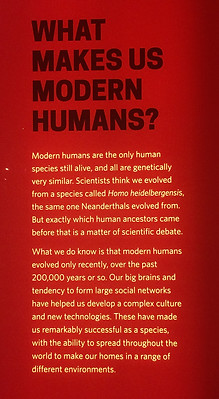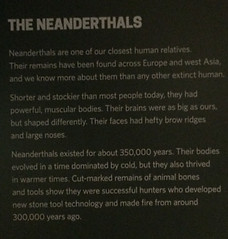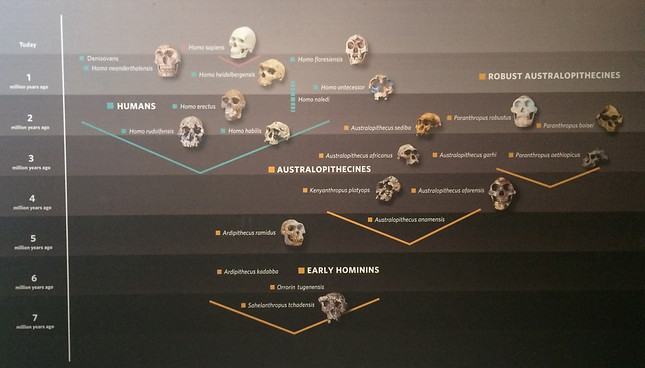Conclusion
'Much of the beauty of the concept of evolution lies in its elegant simplicity.' (Jay T. Stock-Leverhulme Centre for Human Evolutionary Studies, University of Cambridge). Despite the concept of evolution being most commonly and famously associated with the English naturalist Charles Darwin, the conception has roots in ancient Greece, Rome and China. Evidence proves that countless animals, including humans, have adapted in the past through many contrasting forms of evolution; however scientists now pose the question: Are modern day humans still evolving?
Genetic and archaeological evidence indicates that all humans share a common ancestor who originated in Eastern Africa 200,000 years ago. Subsequently, modern day humans exhibit greater genetic unity than most other species; this has lead many to assume natural selection ended with the origin of current Homo Sapiens. However, the diversity seen within our species remains to be explained, with numerous scientists researching genetic drift as an answer.
Many scientists also believe that evolution no longer applies to humans, and that now, as a species, we rely on culture and technology for survival rather than random changes in our genetics; so much so that cultural adaptation has replaced biological adaptation.
Adaptation refers to a mechanism that allows organisms to mediate the stresses of their environment to guarantee survival and reproduction. During the past 12,000 years, humans have increasingly used culture and technology to mediate their environment and to diminish stresses that could cause genetic adaptation; consequently, Homo Sapiens have not had the pressure required for biological adaption. The earliest direct evidence of cultural adaptation might have been the first use of fire at an estimated 700,000 years ago; this is thought to have allowed the early human species Homo Heidelbergensis to migrate and occupy northern latitudes. Since then, culture and technology has played a significant role in the successful colonization of the world by our species through the use of housing, watercraft and versatile tools. However, it is clear that most of our non-genetic forms of adaption depend on resource availability provided by agriculture. As a result, these methods of environmental buffering may not be adequate in all circumstances.



Within the past 50,000 to 70,000 years, after the migration of Homo Sapiens out of Africa, much of the genetic variations seen within current humans was developed. A lot of this variation is thought to have been caused by genetic drift resulting from random gene changes in small populations of hunter-gatherers who were migrating to other areas of the world; as these populations increase in size, they amplify the changes in the genetics of the individual populations. Subsequently, the variability seen within our current species might be non-adaptive and could have been caused by random occurrences linked to the pattern of human dispersal. Genetic Drift may be less important in the future as it is most significant in small populations and currently human populations are too interconnected to be isolated in specific geographic locations.
However, the spatial distribution of numerous biological characteristics within our species is not due to chance; an example of this is the variation of pigment found in skin that contrasts with each individual person in accordance with variability in light exposure and geographical location. This variation in genotype and phenotype evolved after the origin of modern Homo Sapiens although it has been argued that it occurred before the founding of agriculture and so subsequent technological advancements have shielded humans against further environmental stresses. Globalisation has already occured which lead to a subsequent increase in gene flow as different races interbreed, this means that skin pigmentation is no longer strictly linked to geographical location but rather a result of migration and interbreeding.
There are, nonetheless, instances of human evolution that occurred following the origin of agriculture and that involve the co-evolution of both genetic and cultural systems. The most well known example of this is evolution in the form of natural selection of heterozygous carriers of the recessive sickle-cell gene to preserve sickle-cell anaemia in populations exposed to malaria. This natural selection is notably visible in regions of Central Africa where tropical forests have been deforested for agriculture, causing a rise in the population of mosquitoes that transfer the Plasmodium parasite that causes malaria. The reason for this genetic adaption is disease which, as an environmental stressor, can easily break through technological and physiological barriers of the human genome.
Studies provide clear evidence that natural selection has been influencing Homo Sapiens since the founding of agriculture, however the evidence relies on distinguishing markers for recent evolution in genetic diversity. Scientists have therefore argued that future technological advancements will provide progressively efficient barriers to shield the human genome from natural selection.
Finally, there are many reasons to believe that our species have not stopped evolving biologically and that there will be many future natural selective pressures that have to be faced. Our current cultural and technological abilities to mediate environmental stress depend on an economic system based on the efficient allocation of agricultural resources. This economic system was founded in the last 12,000 years which has been the most climatically stable period of time within the course of human evolution, characterized by gene flow and environmental stability.
We would not expect major adaptive changes unless in the presence of major geographic issues, such as isolation, major occurrences of extinction or significant environmental instability; there is now sufficient evidence to forecast a period of climatic instability where our technological advancements may not be sustainable enough to continue to mediate environmental stress. Our future evolution depends on whether we will be able to adapt successfully through technological and physiological means; natural selection occurs due to a change in environment and our environment is changing. The relative importance of natural selection in our evolution is weak today but has the capability to play a more significant role in our adaption in the future.